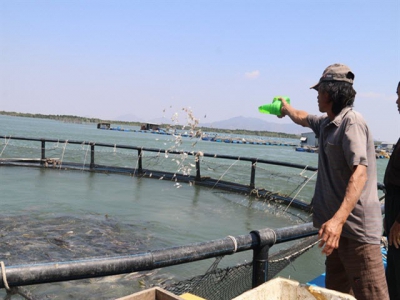Việt Nam begins to realise marine aquaculture potential

Ho Chi Minh City – Coastal aquaculture is being developed in many localities but the output is very small compared to the country’s potential, experts have said.
Breeding fish in floating cages in Vũng Tàu City’s Long Sơn Commune. – VNA/VNS Photo Hoàng Nhị
The marine aquaculture area and output increased by 20 per cent every year since 2010 to 258,000ha and 431,600 tonnes last year.
The most popular species are fish, bivalve molluscs and crustacean species besides seaweed.
Marine aquaculture has developed rapidly in the northern province of Quảng Ninh, the Cửu Long (Mekong) Delta province of Kiên Giang and some central provinces.
Kiên Giang has 3,000 floating cages at sea to breed marine fish, mostly grouper and cobia.
In Khánh Hòa, a marine aquaculture hub in the south-central region, farmers breed mostly lobster, cobia, yellow pomfret, and snapper.
The central region from Bình Định to Ninh Thuận provinces accounts for half of the country’s lobster breeding area with 2.7 million cubic metres of cages and has an annual output of 1,500 tonnes.
Speaking at a seminar in Khánh Hòa last week, Trần Công Khôi, deputy head of the directorate’s aquaculture department, said the country depended on wild and imported lobster fry. It imported around five million fry a year, he said.
The country still lacks zoning and advanced farming techniques, resulting in low efficiency and environmental pollution, according to Khôi.
With more than 3,200 km of coastline and more than 3,000 islands, the country has around 500,000ha of ocean surface with potential for aquaculture, according to the Directorate of Fisheries.
The country has 20 million people living in coastal areas and islands.
The alluvial grounds of estuaries in the Mekong and Hồng (Red) River deltas have the water salinity and food resources required for farming bivalve molluscs.
To sustainably develop aquaculture, many localities have adopted advanced techniques using Norwegian technologies.
Trần Hữu Thế, deputy chairman of the Phú Yên Province People’s Committee, said the Norwegian technologies helped curb environmental problems related to coastal aquaculture.
One of them, used on farms on land, works by not releasing wastewater into the environment.
“This technology can be used to breed lobsters,” Thế said.
Another, which involves farming fish far away from the shore at sea, ensures the safety and cleanliness of the water.
Phú Yên and Khánh Hòa are the two largest lobster producers in the central region.
Deputy Minister of Agriculture and Rural Development Phùng Đức Tiến said the Government had rolled out a number of policies and programmes to promote marine aquaculture.
Infrastructure for aquatic species seed breeding, concentrated marine aquaculture and supporting and processing industries for marine species had been created, he said.
But coastal aquaculture is still in a fledgeling phase, according to the Research Institute for Aquaculture No. 1.
Marine aquaculture is small in scale and lacks infrastructure, and faces many challenges related to seeds, feed, diseases, and pollution.
Most marine aquaculture farms are close to shore and face problems like pollution.
There are a few companies that farm fish at seas on an industrial scale. Bình Định, Phú Yên and Khánh Hòa provinces, for instance, have one such company each focused on exports.
In July this year Kiên Giang Province gave approval to Mavin Group to invest in a 2,000ha export-focused farm off the coast of Kiên Hải District.
The US$30 million project is scheduled to begin operating in 2021, producing 30,000 tonnes of fish a year.
Development
The Ministry of Agriculture and Rural Development has drafted a sustainable marine aquaculture strategy for the period up to 2030 and submitted to the Government for approval.
It targets having 270,000ha of marine farms, including 6,000ha offshore, by next year and an annual output of 710,000 tonnes.
By 2030 it aims to expand to 300,000ha, 30,000ha and 1.75 million tonnes. By then exports will be worth US$4 - 6 billion.
Tiến said the country would shift from traditional farming to an industrial scale and adopt advanced techniques.
It would promote sustainable aquaculture and fishing and adopting advanced techniques in breeding, fishing, preserving, and processing seafood to produce high-value products, he said.
It would focus on green technologies to develop all areas of marine aquaculture like breeding, fish health, feed, farming techniques, and post-harvest handling and processing, he added.
Có thể bạn quan tâm
 Price of commercial lobster increases by 200-300 thousand VND per kilogram
Price of commercial lobster increases by 200-300 thousand VND per kilogram This is the end of the 2018-2019 season for commercial lobster farming. Farmers in Nhơn Hải commune of Quy Nhơn city, Bình Định province are harvesting
 China opens market for three more kinds of Vietnamese aquatic products
China opens market for three more kinds of Vietnamese aquatic products The General Departent of China Customs has announced via a diplomatic note the agreement to supplement three kinds of Vietnamese aquatic products allowed
 China bans shrimp imports from Ecuador, an opportunity for Vietnamese shrimps?
China bans shrimp imports from Ecuador, an opportunity for Vietnamese shrimps? After China’s ban, Ecuadorian shrimp exports to this market have decreased, but what about with Vietnamese shrimps?